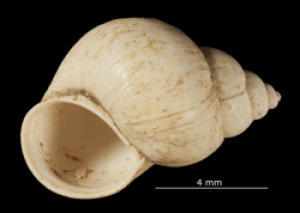利用“氨基酸记时螺壳”方法,约克大学的科学家开展最大规模的项目去记载大约3百万年前的英国第4纪时期。已有40年的氨基酸地质年代学技术改进后首次应用,这一技术通过检测蜗牛壳化石中蛋白质系统的分解状况,提供一种记载考古和地质遗迹的方法。

Bithynia 螺壳
英国拥有来自第4纪丰富的化石沉淀物,这些研究材料出现在相当长的冰川时期(被称为冰河时代)。但是过于频繁的间冰期沉淀很难反映全球气候变化。
氨基酸消旋新技术能把深海沉淀物的环境记录联系到过去3百万年间的气候变化,这一研究发表在最新一期Nature上。
约克大学考古学院Kirsty Penkman博士和Matthew Collins 教授共同开发这一新技术,钙质化石中蛋白质分解程度用于检测。基于内部氨基酸结晶分析,这一技术能够准确记载时间跨度大的化石遗迹。
利用新方法,横跨整个第4纪的74个化石遗迹按时间先后排序,它的时间关系与地层学的一致。这一研究由English Heritage、Natural Environment Research Council 和Wellcome Trust共同资助。(生物探索译 Pobee)
生物探索推荐英文摘要
A chronological framework for the British Quaternary based on Bithynia opercula
Abstract:Marine and ice-core records show that the Earth has experienced a succession of glacials and interglacials during the Quaternary (last ∼2.6 million years), although it is often difficult to correlate fragmentary terrestrial records with specific cycles. Aminostratigraphy is a method potentially able to link terrestrial sequences to the marine isotope stages (MIS) of the deep-sea record. We have used new methods of extraction and analysis of amino acids, preserved within the calcitic opercula of the freshwater gastropod Bithynia, to provide the most comprehensive data set for the British Pleistocene based on a single dating technique. A total of 470 opercula from 74 sites spanning the entire Quaternary are ranked in order of relative age based on the extent of protein degradation, using aspartic acid/asparagine (Asx), glutamic acid/glutamine (Glx), serine (Ser), alanine (Ala) and valine (Val). This new aminostratigraphy is consistent with the stratigraphical relationships of stratotypes, sites with independent geochronology, biostratigraphy and terrace stratigraphy. The method corroborates the existence of four interglacial stages between the Anglian (MIS 12) and the Holocene in the terrestrial succession. It establishes human occupation of Britain in most interglacial stages after MIS 15, but supports the notion of human absence during the Last Interglacial (MIS 5e). Suspicions that the treeless 'optimum of the Upton Warren interstadial' at Isleworth pre-dates MIS 3 are confirmed. This new aminostratigraphy provides a robust framework against which climatic, biostratigraphical and archaeological models can be tested.







